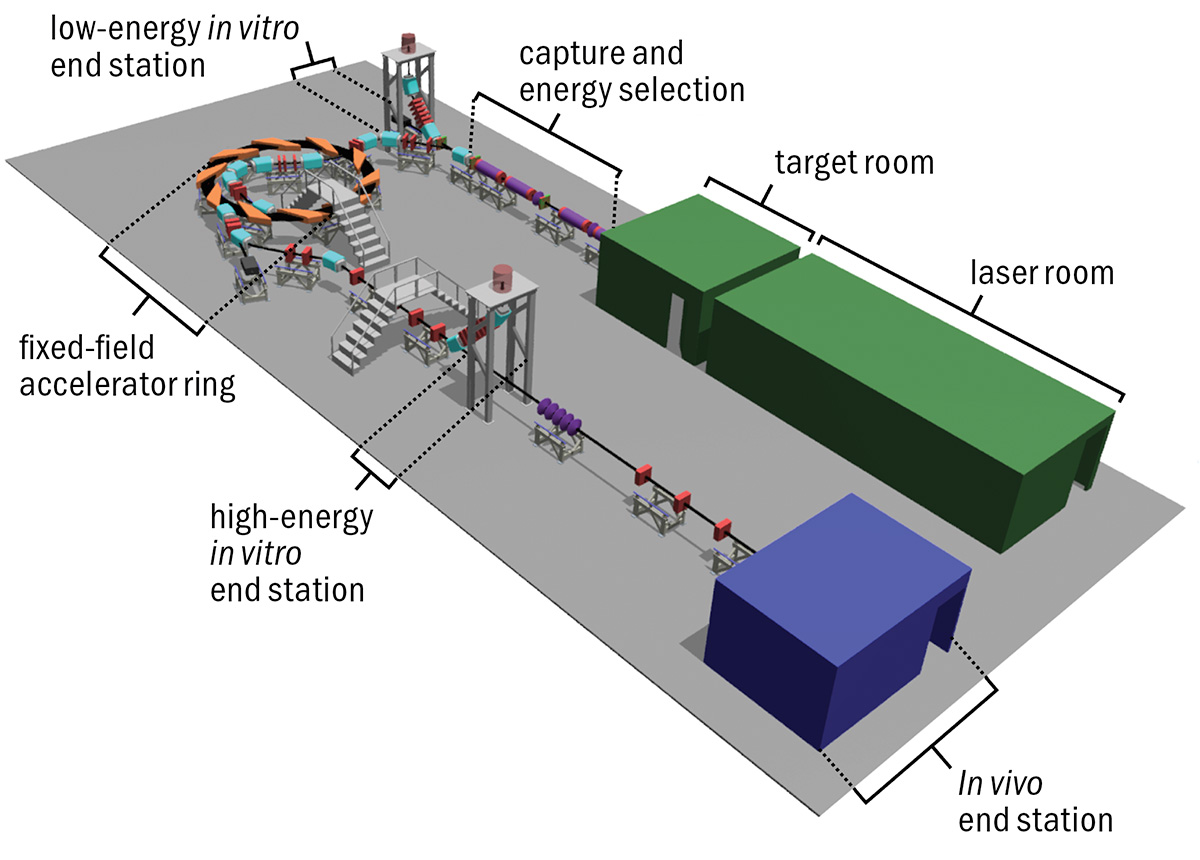The UK-led LhARA collaboration seeks to establish an entirely new technique for the automated delivery of personalized, precision, multi-ion Particle Beam Therapy (PBT), which will revolutionize cancer treatment. It will be a hybrid system consisting of a high-power pulsed laser of protons and ions, which are captured and formed into a beam by strong-focusing electron-plasma lenses known as Gabor lenses. Rapid accelerations will be performed using a spiral scaling fixed-field alternating-gradient (FFA) accelerator.
If successful, this new technique will have the greatest impact on the most difficult cancers to cure while at the same time stimulating new research directions in fundamental physics, material science, and radiation biology.
The steps fixed by the Lhara collaboration are:
- Funding is sought from UKRI for an initial concept and risk-mitigation phase
- Funding for building the research facility in the UK
- R and D costs over ten years and development of the concept of the clinical facility
- Development of commercial product

Schematic of the LhARA facility. The first stage involves a pulsed laser incident on a target, with the emitted particles being captured by a Gabor lens, providing a facility suitable for studying the radiobiology of cell cultures. In the second stage, the low energy beam from the first stage is accelerated using a fixed-field, alternating gradient accelerator (FFA), to energies suitable for small-animal radiobiology studies. (SOURCE: CERN Archive)
Recent Progress
In 2023, the consortium published their pre Conceptual Design Report outlining their radiobiology programme and their R&D progress. By 2029, the consortium is set to publish technical details about the laser source, accelerator components, detection and diagnostic instrumentation as well as providing a comprehensive project strategy. If funding acquisition and R&D occurs on schedule then the project will be built in two stages. Low-energy beams will be directed toward the end station for measurement, ensuring that beam diagnostics are well-characterised. Once these parameters are optimised, irradiation experiments will commence, exposing cell cultures to both protons and carbon ions. This will verify that the dose distribution aligns with simulation predictions.
Having gained thorough understanding of Gabor lenses specification and the low energy beam dynamics, LhARA will progress to stage 2. This stage will connect stage 1 apparatus to the FFA accelerator and incorporate transfer lines to 2 additional end stations. Stage 2 will have an expansive experimental programme, exploring effects on both cells and live animal models at higher energy values. LhARA will maximise scientific output by conducting experiments at low energy and high energy stations simultaneously. As outlined here, LhARA will conduct studies that help researchers to understand how radiotherapy kills cancerous cells as well as how the underlying biological mechanisms vary under different conditions.
After this extensive experimental programme has concluded, the consortium hopes to translate their findings to clinical applications, ultimately improving patient outcomes in radiotherapy.
PPD INVOLVEMENT
PPD are contributing to this experiment by producing accurate simulations for the proton beam dose distribution. As protons traverse a medium, they deposit energy at a rate inversely proportional to their velocity. As they slow down, energy deposit increases, eventually culminating in a sharp increase in energy just before stopping, known as the Bragg peak. The position of the Bragg peak can be adjusted by modifying the initial energy of the protons. By doing so clinicians are able to calculate the required energy to deliver the dose precisely to a tumour at a specific depth, effectively targeting the tumour while minimizing exposure to surrounding healthy tissue.
Particle Physics Department is helping to develop a GEANT4 simulation that models proton energy distribution in tissue across a range of initial energies. The basis for this simulation is an experiment conducted by members of the LhARA collaboration, this experiment involves firing a proton beam into a tank of water loaded with scintillator.
Rapid energy deposition at the Bragg peak causes localised heating, this prompts a sudden change in pressure, generating acoustic waves at ultrasound frequencies. Transducers are positioned all around the tank, to detect these emitted frequencies. Based on the position and intensity of the Bragg peak, the signals produced will differ in shape and intensity. The combined transducer signals can then be assigned to position of the Bragg peak, matching the initial beam energy to a known Bragg peak depth. The results enable the creation of a simulation model that can help predict the Bragg peak depth for a given initial beam energy.
The water–liquid scintillator mixture emits light upon excitation. The light signal detected via a photomultiplier or camera, is therefore able to validate the model and facilitate energy reconstruction from the induced sound.
Engineers from STFC’s ISIS Neutron and Muon Source have developed FFA magnet lattice designs, focusing on beam flexibility and energy efficiency. These designs have undergone simulations to ensure high magnetic field quality. Meanwhile, ASTeC at Daresbury Laboratory is playing a crucial role in designing and simulating key accelerator components, including the laser source, capture region, low-energy line, FFA, and high-energy line.
Once operational, LhARA will be capable of delivering radiation doses higher than any existing facility. Achieving this requires maintaining initial shot-to-shot laser stability. To address this, the Central Laser Facility is actively working on modelling initial beam dynamics to enhance system performance.
